|
|
|
|
Products mentioned in this Article
|
|
|
|
|
|
|
|
|
 |
|
|
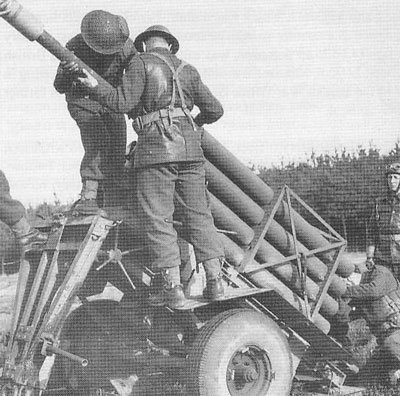 |
The Land Mattress:
Canadian Ingenuity Takes Flight
with Andrew J. Lucas
The Land Mattress, a multi-barreled rocket launcher was the brain child of Canadian artillery officer Lt. Col. Eric Harris and perhaps more than any other Canadian weapon of the war demonstrates not just ingenuity but versatility. Necessity is often called the mother of invention and war the crucible of progress, in late 1944 Canadian forces fielded a rocket launcher that demonstrated both these philosophies. The first prototype of what would evolve into the Projector, Rocket, Three Inch, Number 8, Mark I, better known as the Land Mattress was originally the brainchild of a British officer, Lt. Col. Micheal Wardell. While serving in North Africa, Wardell’s unit was engaged by German forces and in danger of being overwhelmed.
Left: Loading the Land Mattress one rocket at a time.
|
| He successfully convinced a nearby anti-aircraft battery to direct their
rocket projectors against the enemy. The results were impressive and
broke the enemy’s morale, though it actual effectiveness was not
determined at the time aside from turning back the assault of course. Wardell returned to England and using the Naval Mattress generally used
for amphibious landings as a template for his multiple rocket launcher
he developed a prototype. In early 1944, he demonstrated his projector
to the representatives of the British War office at Larkhill’s British
School of Artillery. His prototype suffered from a number of
deficiencies which the British were unable to overlook. The general
consensus was that the system had merit but it would take up to two
years to fully develop. |
While the War Office may not have been interested in Wardell’s
prototype, Harris, who had been invited to attend the demonstration as
an observer, was. The Canadian officer had been interested in rocket
projectors for some time and in fact had attended similar a
demonstration in 1943 which led to Canadian officers officially being
assigned to the British Rocket Research Establishment. Harris invited
Wardell, with the blessing of the War Office, to develop a Canadian
prototype. Wardell, Harris and the First Canadian Army enthusiastically
set about creating the system and drawing upon all the knowledge and
favours they could to do so.
Learn more about the Land Mattress in Flames Of War here...
Right: An example of a fully-loaded Land Mattress.
|
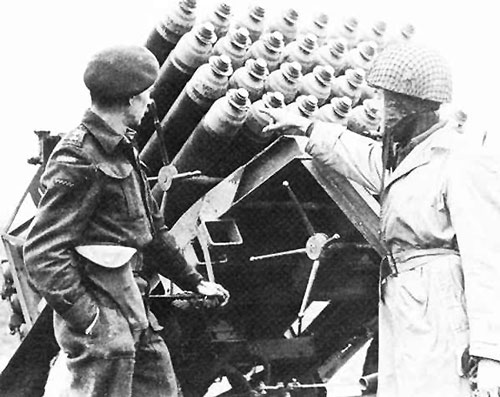 |
The First Canadian Army set a number of guidelines and requirements on the project which made it a challenge to complete. First and foremost was an ingrained reluctance in artillerymen to embrace the opportunities a rocket system held over artillery pieces. There was also some resistance amongst the English to release the equipment needed to develop, test and outfit the rocket projectors, which was no doubt exacerbated by the fact that the system would be combining parts from a number of shall we say unique sources. Harris and Wardell demonstrated a resourcefulness driven by desired function and an abundant supply of equipment discarded or deemed inadequate by other services.
|
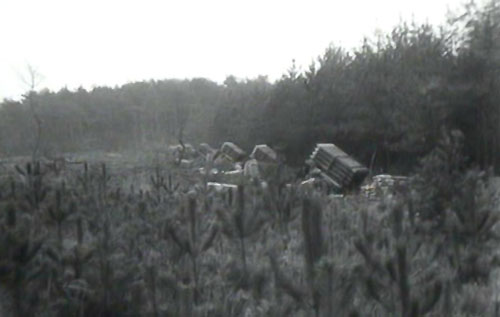 |
The prototype launcher was largely a unique piece
of equipment designed from the ground up, but the rocket was a
Frankenstein creature. The rocket was of course unguided combining a 29lb Royal Navy warhead mounted on an Air Force 3” rocket and topped by
an Army base detonating fuse. Two 40 tube launchers were built as a
proof of concept and in June 1944 a single test salvo was launched at
Aberporth, Wales achieving a maximum range of 8,250 yards. A second
salvo was fired in July which resulted in the project receiving the go
ahead to begin operational trials.
Left:
Lined up during Operation Veritable.
|
It is important to note that there were other prospects for British rocket launchers, one of which also made it to the prototype stage. It featured 84 tubes lifted directly from the Naval Mattress design and mounted on a semi-trailer, but was judged inadequate for a number of reasons. Chief among these were the dual requirements that the projector was mounted on full trailer chassis which was in short supply at this stage of the war, and that a trailer mount would not provide the ability to adequately traverse the system. But perhaps the most important consideration was the fixed range of 3,500 yards with no ability to adjust the range. The Land Mattress did not suffer from these limitations and the comparatively small size of the equipment meant that it could be towed by the same lorry which carried the weapons reloads and the crews were able to easily adjust the aim of the weapon by hand.
|
Even with the green light being given to the project Wardell and Harris
still faced an uphill battle to operationalise the Land Mattress. Aside
from reluctance among British officers to allow rockets to creep into
the domain of their big guns, there were manpower considerations to
consider and an overriding concern that a new weapon would interrupt the
supply of conventional ammunition required on the front lines. With the
full support of the Canadian Corps greasing the wheels and laying down
the law, the Land Mattress was created but with the hallmark of many
Canadian developed weapon systems such as the Defrocked Priest or the
Mosquito fighter bomber it made use of some - unique solutions.
Right: Loading proved was man-power intensive. |
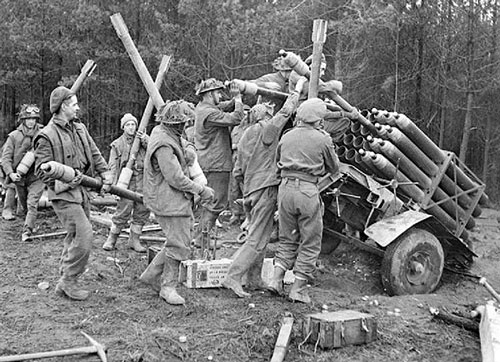 |
|
The development team called in a lot of favors
to create the rocket projectors and utilised project management techniques that today would most likely result
in an inquest or someone losing their job. For instance the team called the director of the Pocket Research Establishment to
authorize a small bottling plant, Meyer-Dunford to build ten projectors as
samples for so called operational trials. The equipment was build without extensive blueprints or schematics and
used military engineers in the civilian plant to build them. The project also liberated manpower from
light anti-aircraft gun crews to both man and prepare the ammunition for the
rocket projectors. The soldiers had been
largely idle due to the Allied domination of the skies from 1944 on. These men
not only provided the operational crews which would operate the equipment but
they were also used to sort through 600,000 fuses scrapped by the British Army
as unsafe, but deemed adequate by Canadian Forces. Once the fuses were obtained along with
11,000 warheads, modified to accept the approved type 721 fuse, special
adaptors and fins were manufactured to mate the warhead to the RAF rocket
motors. Two base plates taken from 3”
mortars acted as supports at the rear of the projector while a jack allowed the
tubes to elevate within a 30-45° arc. Accuracy issues and the ability to hit targets at closer ranges were
solved by rifling the launching tubes and using a selection of three
progressively larger spoilers which would be attached to the warhead to disrupt
the airflow around the rocket thereby lessening the range. The entire unit was a mishmash of scrounged
and refunctioned equipment combined with unusual solutions.
|
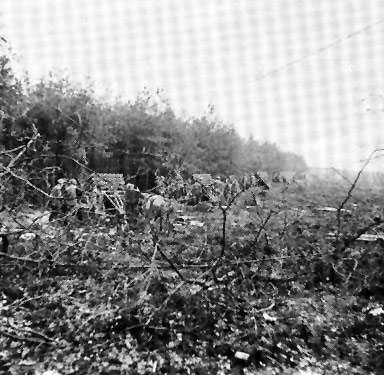
|
The final unit came together quite well and
was sent to Bruges
France to begin operational trials using the 10 Meyer-Dunford prototypes. On 10 September 1944, the ten officers arrived in France to beginning developing the gun
drills. These ten would form the core of
the school and provide training for the battery crews, modify the prototype
projectors which for all purposes were considered combat operational as well as
adjusted the range tables based on performance and the unexpected effects of
light winds on the relatively slow moving rockets. The prototype units were
loaded onto the SS Sammont and delivered to the school on 30 September and by the
end of operational trials in December 1944 all ten Meyer-Dunford and two
Tillings-Stephens prototypes were assigned to the unit now officially
named the 1st Rocket Battery, Royal Canadian Army. Amazingly, a scant nine weeks had passed from the
building of the first prototype to outfitting a twelve unit combat ready rocket
battery.
Left: Last minute preparations before firing.
|
With the equipment built and a supply of rockets prepared all that was left was the training and deployment of the battery itself. On 15 October 1944, 112. Canadian Light Anti-aircraft (LAA) Battery arrived in Bruges, Belgium and utilising foolscap paper as a training manual began the gun drills. Three days later, two Tillings-Stephens prototypes and all ten Meyer-Dunford rocket projectors arrived. Unfortunately the channel crossing had been particularly rough and all twelve projectors had been damaged in transit. By the 29 October, eleven of them had been repaired with one of the Tillings-Stephens models so badly damaged that it was returned to England, and the first demonstration of a full battery salvo was conducted. The first operational trail against a hostile force occurred two days later.
|
This marked the first use of rocket projectors against an enemy unit, aside of course from the use of the Navel Mattress which the Royal Navy used mainly to clear mines prior to an amphibious landing. The battery was mobilised to support an attack on Flushing with a medium gun regiment positioned in front of the battery to protect it. A primary target was selected; an open-topped German anti-aircraft gun position and three troop salvos (utilising four rocket projectors for each salvo) and a number of individual projector salvos were launched at the target.
Right: A plentiful supply of rockets was a requirement for the Land Mattress.
|
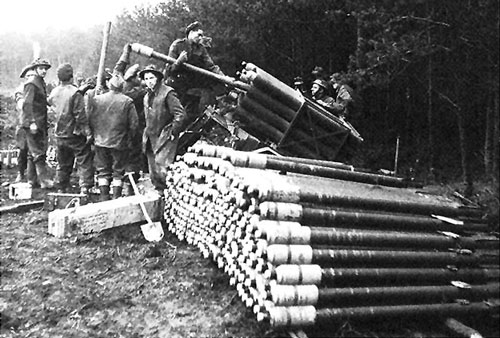 |
Each troop salvo alone consisted of more or less
128 rockets arriving within 20 seconds. Each warhead was the explosive
equivalent of a 5.5” shell and while the launcher was not capable of
sustained fire in the same way that a standard artillery gun was, for a
short time a single launcher can match the effect of an entire
regiment. The shock and awe of delivering that amount of
explosive with little warning and in a fairly contained area was
impressive. The morale effect of the rocket assaults was considerable
and even Allied regiments took cover when the Land Mattress launched a
salvo.
The second operational trial occurred in November 1944. The battery supported the First Polish Armoured Division which was assaulting German forces dug in at Breda-Moerdijk. At dawn, 764 rockets slammed into German positions followed by a number of individual troop salvos. The attack itself claimed 150 enemy casualties and 400 prisoners at the cost of only 12 Polish soldiers. One salvo in particular caught a group of 90 enemies in the open which immediately surrendered after taking 30 causalities. The Polish division credited the success of the assault to the efforts of 1st Canadian Rocket Battery.
On the basis of the operational trials the project was moved to operational status. The gun drills were further refined, repairs to three projectors damaged by premature launched rockets were completed and the unit officially deemed a success. It was concluded that a battery salvo could effectively neutralise a 730 metre (800 yard) area occupied by the enemy in the open or in light defenses. It was further believed that to effectively accommodate the slow reloading time a further two batteries should be commissioned. The 1st Canadian Rocket Battery was deployed with the ten Meyer-Dunford and two Tillings-Stephens rocket projectors manned by personnel drawn from 112. LAA Battery and later 337. and 338. Battery Royal Artillery, and then 6. LAA Regiment, 2. Canadian Corps as the unit moved from Canadian to British back to Canadian control and idle light anti-aircraft battery personnel were rotated through the Land Mattress Battery Cadre training school.
|
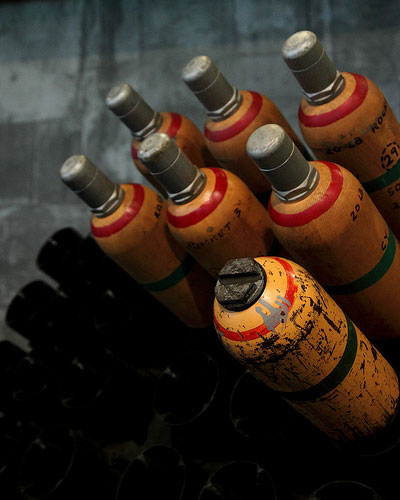 |
The projector system was not without drawbacks however. Reloading the system took between 10-15 minutes for each of 30-32 rockets to be individually loaded into its tube, and then connected to an electronic ignition system. Care had to be taken while reloading as the rocket fins could become bent by the rifled tube if they were loaded roughly. Each rocket was then connected to a pair of 6 volt batteries by a set of `pigtail` connectors, each of which was required to be connected separately to the rockets. The batteries had an operational life of about ten days before requiring a two day recharge cycle. The rigors of use eventually caused the elevation and traversing gears to jam, necessitating frequent field repairs. A more concerning issue was the durability of the firing control boxes which were prone to shorting out when the reset switch was pressed. This occasionally resulted in the unexpected launch of a rocket, which certainly made the reloading process more interesting.
Left: A close-up of the warhead of the rocket projectiles.
|
The rockets themselves were shipped to the launching site where the
warhead, rocket motor and fuses were assembled by the battery crew prior
to launch. This consumed a lot of manpower and time preparing
ammunition prior to an attack. Near the end of the war assembled
rockets were transported to the launch site by stacking them like
cordwood in the 60 CWT transport trucks, practice that left a lot to be
desired safety wise. This would later be adopted as the standard
ammunition transportation practice with 15 Bedford LAA gun tractors
specially modified to carry a complete salvo in each truck. The
launchers were also unable to quickly change their ranging as each
rocket required a specific spoiler to be screwed onto its nose to lower
its range from between 4000-8000 yards making it difficult to hit
targets tracking through different range bands.
During the last years of the war the Land Mattress was permanently deployed from a base camp in Tillbury, Holland from which it supported the British Army in a number of operations including Operation Guildford (alongside 15th Scottish Division) and Operation Veritable (engaging 33 targets with over 13,300 rockets). By mid-1945 the original Meyer-Dunford units were experiencing poor performance due to the wear and tear of use and 18 March they received twelve of the production Tilling-Stephens models followed by a further twelve more on 16 April to replace the Meyer-Dunford prototypes. The new models were lighter, had only 30 tubes (five rows of six tubes to the Meyer-Dunford’s four rows of eight tubes), increased elevation and traverse arcs, but also required extensive field modifications to use in the field, specifically to the weak baffle plates on the tubes and sloppy welds on the rocket tail fin adaptors. However, with a full complement of 24 rocket projectors more batteries were able to be fielded.
|
April was also auspicious in that when scouts reported three German self-propelled guns headed towards the battery, in preparation to repel the assault the unit aimed a single Land Mattress along the road at a 3° elevation loaded with a full salvo. On previous occasions, the battery had been unable to engage targets of opportunity and was quite enthusiastic to engage the approaching vehicles and by all accounts was crest fallen when they didn’t appear. If the vehicles had been spotted and the Land Mattress actually fired from this angle the Germans would certainly have been surprised but it was equally likely that poorly braced rocket projector would have been catastrophically damaged.
Right: The last surviving Land Mattress on display in the Canadian War Museum.
|
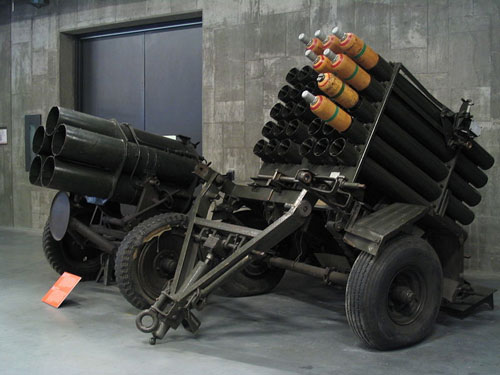 |
As to the effectiveness or accuracy of launching
rockets in this manner when the units were meant only to be used with
an elevation of between 25° and 48°, is anyone’s guess. In any event at
this stage of the war, enemy targets were scarce with nine salvos fired
between 25 April and the end of hostility in Europe.
The Land Mattress was a perfectly serviceable rocket projector, which unfortunately arrived too late in the war to live up to its full potential. It was well received by the infantry units it supported and once in the field even the most reluctant British Artillery officer acknowledged its worth. While not a game changing weapon in and of itself, the Land Mattress epitomised the Canadian spirit of improvisation and daring. In many ways the weapon slapped together a visionary artillery system using discarded, substandard and ill fitting equipment from all three branches of the British Armed Forces, cobbled together into an effective and stunning area effect weapon.
~ Andrew.
Sources
Cinderella Army: The Canadians in Northwest Europe 1944-1945 by J. T. Copp.
The Land Mattress in Canadian Service by Doug Knight.
Canadian War Museum Fact Sheet No. 4 by Don Dingwall and Tom Bond.
|
Last Updated On Thursday, March 7, 2013 by Blake at Battlefront
|
|
|